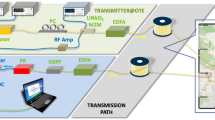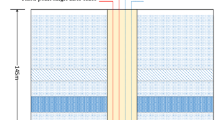Abstract
Distributed acoustic or vibration measurements on a fiber optic communication line (FOCL) began rapid development in 2005. One of the effects used for this purpose is the Rayleigh scattering effect. Rayleigh scattering is an elastic process caused by local inhomogeneities of the refractive index of a FOCL. Optical pulses with a certain time interval are launched into the optic fiber, and a small part of the backscattered light is recorded by the detector. Small deformations of the optic fiber associated with vibration (or seismic) events change the intensity of backscattered light. Analysis of the interference pattern for each section of the fiber makes it possible to identify the characteristics of the vibration effect on a specific section of the fiber. A key feature of the phase-sensitive reflectometer used in the experiment is the use of a two-pulse phase-modulated optical packet as a probing signal. An experiment was conducted to compare the records of seismic excitations recorded by standard seismic equipment and with reflectometer records. The experiment was carried out on a 200 m straight-line single-mode FOCL buried 30 cm below ground. A 5 kg hammer was used as the seismic vibration source. The blows were delivered to a metal substrate lying on the ground. Time synchronization of the seismic data with the reflectometer data was performed based on the detected first shock intakes. The experience of simultaneous recording of low-power seismic excitations has shown that direct comparison of the response of a fiber optic system and geophones is impossible. The recorded data must be converted to the same physical values. In a specific experiment, the acceleration values measured by the seismic system were converted into displacements. Analysis of the converted data and reflectometer data showed that for small deformations of less than one strain, the optical channels show good signal repeatable accuracy. Optical channel data obtained even with large deformations show that they can be used for seismic engineering purposes make it possible to obtain reliable seismic sections, despite some discrepancies in signal shape. Channel density can compensate for this disadvantage.




















Similar content being viewed by others
REFERENCES
Alekseev, A.E., Gorshkov, B.G., Potapov, V.T., Taranov, M.A., and Simikin, D.E., Dual-pulse phase-OTDR response to propagating longitudinal disturbance, Laser Phys., 2020, vol. 30. 10 p. https://doi.org/10.1088/1555-6611/ab70b0
Alekseev, A.E., Tezadov, Y.A., and Potapov, V.T., Intensity noise limit in a phase-sensitive optical time-domain reflectometer with a semiconductor laser source, Laser Phys., 2017, vol. 27, no. 5. https://doi.org/10.1088/1555-6611/aa6378
Alekseev, A.E., Tezadov, Y.A., and Potapov, V.T., Sensitivity of a phase-sensitive optical time-domain reflectometer with a semiconductor laser source, Laser Phys., 2018, vol. 28, no. 6. https://doi.org/10.1088/1555-6611/aab488
Alekseev, A.E., Vdovenko, V.S., Gorshkov, B.G., Potapov, V.T., and Simikin, D.E., A phase-sensitive optical time-domain reflectometer with dual-pulse phase modulated probe signal, Laser Phys., 2014a, vol. 24, no. 11. https://doi.org/10.1088/1054-660X/24/11/115106
Alekseev, A.E., Vdovenko, V.S., Gorshkov, B.G., Potapov, V.T., Sergachev, I.A., and Simikin, D.E., Phase-sensitive optical coherence reflectometer with differential phase-shift keying of probe pulses, Quantum Electron., 2014b, vol. 44, no. 10, pp. 965–969. https://doi.org/10.1070/QE2014v044n10ABEH015470
Fernández-Ruiz, M.R., Soto, M.A., Williams, E.F., Martin-Lopez, S., Zhan, Z., Gonzalez-Herraez, M., and Martins, H.F., Distributed acoustic sensing for seismic activity monitoring, APL Photonics, 2020, vol. 5, no. 3. https://doi.org/10.1063/1.5139602
Hartog, A.H., An Introduction to Distributed Optical Fibre Sensors, London: LLC CRC Press, Taylor & Francis Group, 2017.
Ilinskiy, D.A., Roginskiy, K.A., and Ganzha, O.Yu., Geophysical technologies for studying the processes of formation of deep oil, Vestn. Gos. Univ. Morsk. Rechn. Flota im. admirala S. O. Makarova, 2018, vol. 10, no. 5, pp. 936–950. https://doi.org/10.21821/2309-5180-2018-10-5-936-950
Ilinskiy, D.A., Ganzha, O.Y., Elnikov, A.I., and Roginskiy, K.A., Self-popup node surveying features and application to arctic shelf investigation. Extended abstract, EAGE Conference & Exibitions: Marine Technologies, Gelendzik, 2019a. https://doi.org/10.3997/2214-4609.201901820.
Ilinskiy, D.A., Ginzburg, A.A., Voronin, V.V., Ganzha, O.Yu., Manukin, A.B., and Roginskiy, K.A., On the creation of digital bottom seismic stations of a new generation: The present and a look into the future, Geoekol., Inzh. Geol. Gidrol. Geokriol., 2019b, no. 2, pp. 87–101.
Jousset, Ph., Reinsch, Th., Ryberg, T., Blanck, H., Clarke, A., Aghayev, R., Hersir, G.P., Henninges, J., Weber, M., and Krawczyk, Ch.M., Dynamic strain determination using fibre-optic cables allows imaging of seismological and structural features, Nat. Commun., 2018, vol. 9. https://doi.org/10.1038/s41467-018-04860-y
Masoudi, A. and Newson, T.P., Distributed optical fibre dynamic strain sensing, Rev. Sci. Instrum., 2016, vol. 87. https://doi.org/10.1063/1.4939482
Shatalin, S., High definition seismic and microseismic data acquisition using distributed and engineered fiber optic acoustic sensors, in Distributed Acoustic Sensing in Geophysics: Methods and Applications, American Geophysical Union, 2020.
Funding
The study was supported by the Russian Foundation for Basic Research (project no. 19-55-45020).
Author information
Authors and Affiliations
Corresponding author
Ethics declarations
The authors declare no conflicts of interest.
About this article
Cite this article
Ilinskiy, D.A., Alekseev, A.E., Ganzha, O.Y. et al. Use of Fiber Optic Communication Lines with a Phase-Sensitive Reflectometer for Recording Seismic Signals. Seism. Instr. 57, 231–248 (2021). https://doi.org/10.3103/S0747923921030051
Received:
Revised:
Accepted:
Published:
Issue Date:
DOI: https://doi.org/10.3103/S0747923921030051




